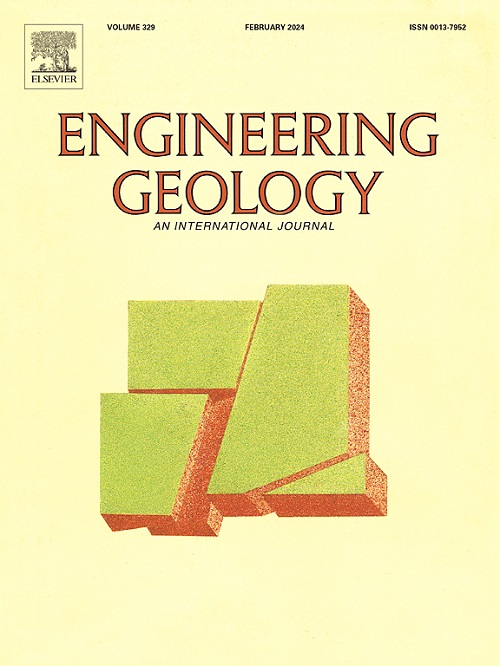Investigation of morphological features and mechanical behavior of jointed limestone subjected to wet-dry cycles and cyclic shear in drawdown areas of the Three Gorges Reservoir
IF 6.9
1区 工程技术
Q1 ENGINEERING, GEOLOGICAL
引用次数: 0
Abstract
Reservoir drawdown induces cyclic water level fluctuations, exposing geomaterials in drawdown areas to repetitive wet-dry cycles and cyclic shearing forces. Understanding the deterioration mechanisms of geomaterials under these conditions is crucial for ensuring the long-term stability of the geomaterials in drawdown areas. This study systematically explores the deterioration mechanisms of jointed limestone from the Three Gorges Reservoir region under these dual effects. Employing three-dimensional white light scanning and EDS (energy dispersive spectroscopy) technology, the morphological and chemical evolution of rock joints was quantitatively characterized. The modified JRC-JCS (joint roughness coefficient-joint wall compressive strength) model was utilized to predict shear strength. The findings reveal that with the increase of wet-dry cycles and cyclic shears times, the surface of joints becomes progressively smoother, and the deterioration rate of shear strength gradually decreases. Cyclic shear primarily damages micro-protrusions, while wet-dry cycling affects both protruding and recessed areas through the dissolution of soluble mineral crystals. Compared with other typical model, the modified JRC-JCS model demonstrated better accuracy in predicting shear strength. The findings reveal the deterioration mechanisms of geomaterials in drawdown areas, providing essential insights for assessing the long-term stability of jointed rock mass in these regions.
三峡库区干湿循环和循环剪切作用下节理灰岩形态特征及力学行为研究
水库下降引起循环水位波动,使下降区域的岩土暴露于重复的干湿循环和循环剪切力。了解这些条件下岩土材料的劣化机制,对于确保滑坡区岩土材料的长期稳定至关重要。本文系统探讨了三峡库区节理灰岩在这双重作用下的变质机理。利用三维白光扫描和能谱技术,对岩石节理的形态和化学演化进行了定量表征。采用改进的JRC-JCS(节理粗糙系数-节理壁抗压强度)模型对节理抗剪强度进行预测。结果表明:随着干湿循环次数和循环剪切次数的增加,节理表面逐渐光滑,抗剪强度劣化率逐渐降低;循环剪切主要破坏微凸起,而干湿循环通过溶解可溶性矿物晶体同时影响凸起和凹陷区域。与其他典型模型相比,修正后的JRC-JCS模型对抗剪强度的预测精度更高。研究结果揭示了收缩区地质物质的退化机制,为评估这些地区节理岩体的长期稳定性提供了重要的见解。
本文章由计算机程序翻译,如有差异,请以英文原文为准。
求助全文
约1分钟内获得全文
求助全文
来源期刊

Engineering Geology
地学-地球科学综合
CiteScore
13.70
自引率
12.20%
发文量
327
审稿时长
5.6 months
期刊介绍:
Engineering Geology, an international interdisciplinary journal, serves as a bridge between earth sciences and engineering, focusing on geological and geotechnical engineering. It welcomes studies with relevance to engineering, environmental concerns, and safety, catering to engineering geologists with backgrounds in geology or civil/mining engineering. Topics include applied geomorphology, structural geology, geophysics, geochemistry, environmental geology, hydrogeology, land use planning, natural hazards, remote sensing, soil and rock mechanics, and applied geotechnical engineering. The journal provides a platform for research at the intersection of geology and engineering disciplines.
 求助内容:
求助内容: 应助结果提醒方式:
应助结果提醒方式:


